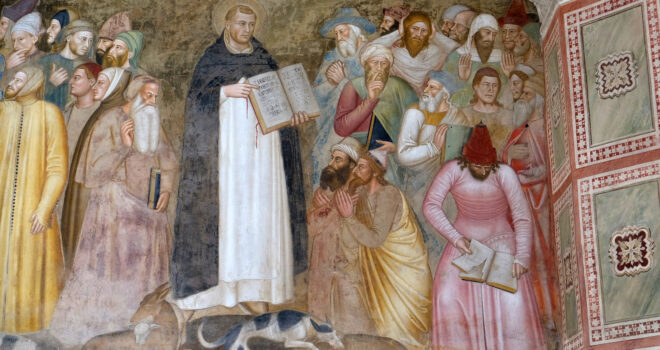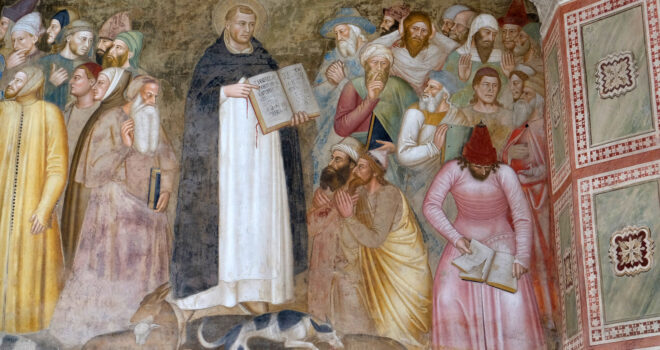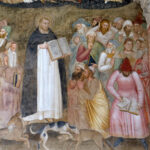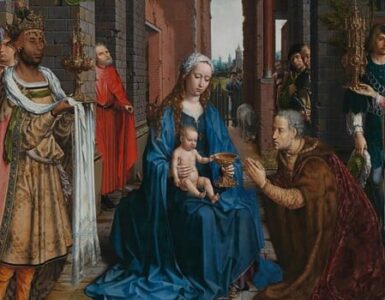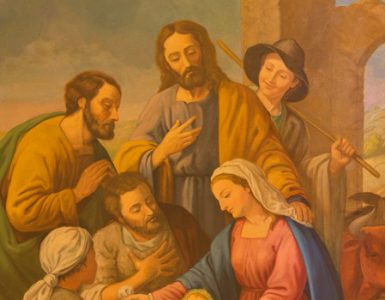In a few week’s time, the season of Easter will be upon us. With it comes the many celebrations of Sacrament-receivers. Whether they be the newly baptized at the Easter Vigil, the recently confirmed at the Cathedral, the first-time receivers of Holy Communion, partners becoming one in Holy Matrimony, or Priests receiving Holy Orders, behind all of those called by God’s grace, there’s a catechist who bridges these souls to their Creator.
In the rich history of our Church, there have been numerous catechists, too many to count, guiding the Church toward more perfect union with God. Some have taught us how to sacrifice ourselves as martyrs, others how to contemplate His glory as religious, and still others have unlocked our minds to the greatness of His mercy through academia, vocational work, and the simplicity of friendship.
As I explore the following five catechetical heroes, think about how much they have in common with the catechists that shaped you into the Catholic you are today.
St. Thomas Aquinas
Every article written about catechists in the Catholic Church must include this great philosopher and theologian. Once dubbed “The Dumb Ox” (due to his quiet demeanor and bulky stature), his academic mind is arguably the greatest the Church has ever known. While his Summa Theologica, a 2.8 million word defense of the Catholic faith, is sufficient enough proof of his sanctity of mind, there’s also his poetry, his sermons, and his multiple other works. Indeed, this Dominican friar truly left a mark on his students, and he continues to do so as his written words resonate with our hearts today, and will for generations to come.
Saint John Baptist De La Salle
There are many Saints who are considered the “Patron Saint of Catholic Education,” but the educator par excellence is by far Saint John Baptist De La Salle. He was born in France to a wealthy family of which he inherited a fortune. He became a priest and helped his brothers and sisters survive in a waning French economy. Moreover, he saw the poor children without hope of advancing in society. He felt called by God to help them. So, he established the Institute of the Brothers of the Christian Schools, a group of religious men who would dedicate their lives to serving the poor as teachers. They took vows. They educated themselves. And together, with St. De La Salle as their guide, raised the hopeless into the light of God’s grace and mercy. Today, La Salle’s brothers continue to guide youth in a world-wide effort to eradicate poverty through Catholic education.
For more resources on De La Salle and his thriving community of brothers, click here.
Saint Miguel Febres Cordero
Almost 150 years after the death of Saint John Baptist De La Salle, another of his brothers would take the Lasallian habit, but not in France. Rather, this brother would don the chevrons and black robes in Ecuador. His name was Francisco Luis Febres-Cordero y Muñoz, but after the choosing his religious name on the day of his acceptance into the brotherhood, he would forever be known as Hermano Miguel.
Francisco was born with a sickness that left him unable to walk. However, he was blessed with a vision of Our Lady that cured him of his ailment. With his renewed strength, his parents enrolled him in the first Catholic school established in his hometown of Quito, Ecuador, headed by the Lasallian missionaries.
It didn’t take long for Francisco to thrive under the care of the brothers. His sharpness of mind and resolute faith earned him several merits from not only the congregation of brothers, but the community of Quito as well. He won several awards for his academic successes and was well on his way to earning scholarships to study in prestigious universities.
But he knew that wasn’t God’s plan for him– he was to become a Brother.
Hermano Miguel thrived as a catechist, especially for the young students he prepared for First Communion. He would ask his students to bring a kernel of wheat to class for every act of kindness they did. Each class, his students would place those kernels in his hand and he would transfer them to a glass jar that sat upon his desk. Once his students were sufficiently prepared for receive Our Lord, he himself would grind the kernels and bake them until they became the hosts that would be consecrated into their First Communion with Our Lord.
Saint Elizabeth Ann Seton
Saint Elizabeth Ann Seton’s road to sanctity was paved by the idea of Catholic education for all. At 19, she married a wealthy businessman who took her around the world. While in Italy, she fell in love with Catholicism. After the untimely death of her husband to tuberculosis, she returned to the United States and converted to the Catholic faith. For many rough years, she worked and cared for her five children.
Once they grew into adulthood, Elizabeth founded the St. Jospeh’s Academy and Free School, a school dedicated to Catholic girls’ education. Not long after, she established her own religious congregation known as the Sisters of Charity of St. Jospeh’s, but later changed that name to the Daughters of Charity to mimic the group founded by St. Vincent De Paul.
She spent the rest of her life as “Mother Seton,” the title that solidified her leadership within the congregation of sisters she founded. Together, they planted the seeds for Catholic education in the United States, a plant whose fruits continue to grow 100-fold.
Saint Katherine Drexel
This rather obscure American Saint is actually a powerhouse of Catholic education in the U.S.A. She was born into a wealthy family, like Saint Elizabeth Ann Seton, but after taking the habit with the Sisters of Mercy in Pittsburgh, PA in 1891, she founded her own religious congregation known as the Sisters of the Blessed Sacrament. Together, they spent their lives serving the needs of the impoverished Native American populations in the western and southwestern United States. They learned their languages, established schools, and nourished their bodies and souls with food, shelter, and education. But, she didn’t stop there – she used her wealth to finance more than 60 missions and schools across the nation including Xavier University of Louisiana, the only historically black and Catholic university in the United States.
+
Six degrees of separation is the theory that any person on the planet can be connected to any other person on the planet through a chain of acquaintances that has no more than five intermediaries. In the Catholic faith, this separation doesn’t exist, for we are connected spiritually in ways that the physical world cannot comprehend, nor dares to fathom. In this mystical union with God, we are not only one with Him, but with all of those he has called to guide His Children into His perfect light.
Perhaps now’s the time for you to carry on their tradition, His tradition, and become (or continue to be) a catechist?
✠
Photo by Renata Sedmakova on Shutterstock


